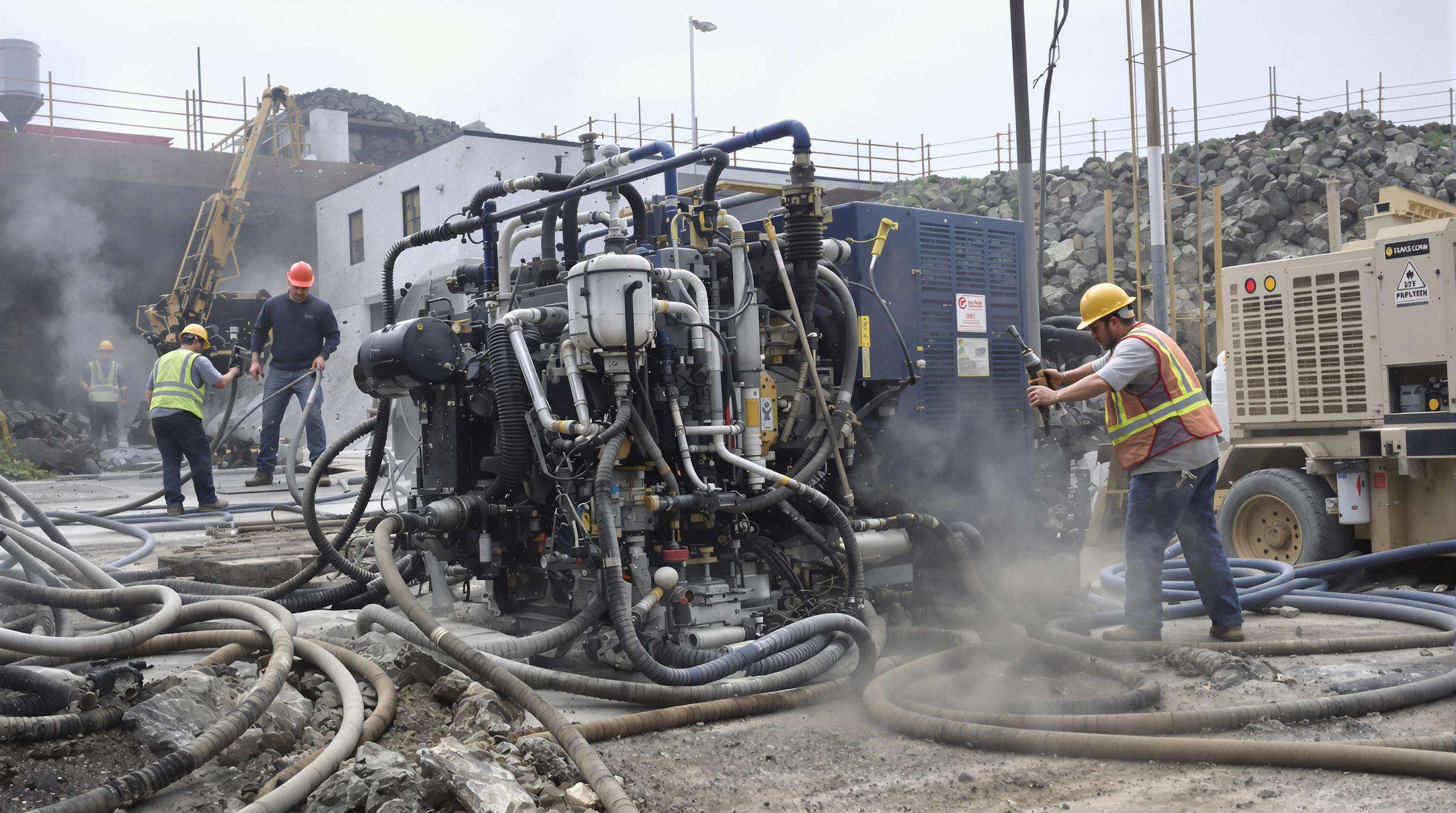Unmatched Reliability and Power for Off-Grid Jobsite Operations
Why Diesel Air Compressors Are Essential for Power Independence
Diesel powered air compressors run nonstop day and night without needing connection to the electrical grid, which makes them absolutely essential for jobs far from civilization like building pipelines or setting up telecom towers in remote areas. Electric versions just can't match this reliability when there's no power available. Diesel machines keep delivering steady airflow around 185 cubic feet per minute even during long power cuts, so workers can still use vital equipment such as rock drills and pile drivers without interruption. A recent survey about energy backup solutions showed that nearly nine out of ten contractors choose diesel compressors for their off grid operations because these units come with built in fuel tanks and work wherever electricity lines simply don't exist.
Performance in Remote and Rugged Environments: Case Study from Mining and Disaster Recovery
The diesel compressors operating in Chile's Atacama Desert managed to stay running at around 98 percent capacity throughout an entire year, even though they faced some seriously harsh conditions. We're talking temperatures regularly climbing past 104 degrees Fahrenheit and locations sitting at nearly 11,000 feet elevation. When Hurricane Laura hit, these machines kept providing essential air pressure for clearing away debris during cleanup efforts. The roads were so badly flooded after the storm that getting fuel to the site took more than three days longer than normal. Looking at both scenarios together shows just how reliable diesel compressors can be, consistently producing well over 90 pounds per square inch of pressure where other types of equipment would simply fail completely.
Durability in Extreme Climates: Arctic Drilling and Oil & Gas Applications
Diesel compressors rated Tier 4 Final can handle the brutal cold of Alaska's North Slope down to -58 degrees Fahrenheit. The latest cold-start tech has really cut down warm-up time too, saving about 40% compared to what we saw back in 2018 models. Over in Saudi Arabia's Ghawar Field things get pretty tough as well. These modified units just keep going through sandstorms that blow at over 55 miles per hour, and somehow manage to keep air purity under 0.01 milligrams per cubic meter. That kind of performance meets those super strict requirements for precision instruments they need there. No wonder then that around three out of four Arctic drilling companies stick with diesel compressors when doing core samples or maintaining wellheads. They just work better in these extreme conditions than anything else available right now.
Cost-Effectiveness of Diesel vs Electric Compressors Over Time

Total Cost of Ownership: Fuel, Maintenance, and Downtime Compared
Diesel air compressors offer 28% lower total ownership costs over five years compared to electric models in remote applications (Ponemon Institute 2023), driven by three key advantages:
- Fuel efficiency: Tier 4 Final engines consume 15% less fuel per CFM than 2010-era models
- Maintenance intervals: Diesel units require 30% fewer service hours in high-dust environments
- Downtime costs: Electric compressors incur 7x higher productivity losses in areas with unstable grid power
| Cost Factor | Diesel Compressor | Electric Compressor |
|---|---|---|
| Fuel/Energy (5-yr) | $18,200 | $24,500* |
| Preventive Maintenance | $6,800 | $9,100 |
| Downtime Losses | $2,400 | $16,800** |
| *Assumes remote grid power surcharges **Based on 120 hrs/year outage (Arctic Engineering Report 2024) |
A lifecycle cost analysis by energy experts shows diesel models reach cost parity with electric units after just 1,900 operating hours in off-grid settings.
5-Year Ownership Analysis: Diesel’s Advantage in Remote and Industrial Use
For contractors operating more than 2,000 hours annually, diesel compressors yield an average savings of $23,100 through:
- Avoiding $0.38/kWh peak demand charges for industrial electric service
- 40% longer component lifespan in high-vibration environments
- Flexible fuel storage enabling continuous operation during supply disruptions
Mining operations in Western Australia reported a 32% reduction in energy costs after switching to diesel compressors, despite a 19% rise in fuel expenses (2023 Mining Fleet Optimization Report).
Debunking the Hype: Limitations of Electric Compressors in Off-Grid Settings
While electric compressors perform well in fixed facilities with subsidized energy, they face major limitations off-grid:
- Require $18,000—$45,000 in grid infrastructure upgrades per site
- Suffer 22% efficiency loss at elevations above 5,000 feet
- Cannot utilize mobile fuel caching during extreme weather
Industry reports confirm diesel remains the only viable option for 83% of oilfield drilling and 67% of disaster recovery operations due to these constraints.
High Power Output and Efficiency for Demanding Pneumatic Applications

Matching CFM and PSI Requirements with Diesel Compressor Capacity
Diesel air compressors typically handle between 100 to 1500 CFM with pressure capabilities reaching as high as 350 PSI, which makes them better suited for tough jobs compared to their electric counterparts. They perform reliably during demanding applications like sandblasting operations that need around 90 to 250 CFM or when testing pipelines requiring pressures from 200 to 500 PSI. Field tests conducted in oilfields last year showed something interesting too. At elevations around 5000 feet, diesel powered machines kept about 98% of their advertised power output whereas electric systems dropped down to only about 45% of what they should be producing under similar conditions. This kind of real world performance gap explains why many industries still prefer diesel options despite advances in electric technology.
Powering Critical Tools: Jackhammers, Sprayers, and Air Wrenches
Diesel compressors supply sustained airflow for high-demand tools:
- Pneumatic breakers (20—90 CFM at 90 PSI)
- Industrial paint sprayers (8—20 CFM at 40—70 PSI)
- Impact wrenches (50—100 CFM at 90 PSI)
In automotive assembly plants, diesel-powered systems reduced tool stall incidents by 63% during high-volume production cycles compared to electric alternatives.
40% Higher Uptime and Reduced Idle Time in Industrial Workflows
Tier 4 Final diesel compressors achieve 90—94% fuel efficiency through advanced turbocharging and aftercooling. Field data from mining operations reveal significant operational advantages:
| Metric | Diesel Compressor | Electric Compressor |
|---|---|---|
| Daily uptime | 22.1 hours | 15.8 hours |
| Idle fuel consumption | 0.8 gal/hr | N/A (grid-dependent) |
Sizing Your Diesel Air Compressor for Peak Load and Continuous Use
For continuous operation, select a unit with 25—30% excess CFM capacity beyond total tool requirements. For example, a 100-CFM concrete pavement breaker performs best with a 130-CFM compressor. Modern diesel models equipped with variable displacement technology reduce fuel consumption by 18% during partial loads while remaining ready for sudden demand spikes.
Mobility, Fuel Efficiency, and Smart Operation in Modern Diesel Models
Portability Across Dynamic Sites: Design Advantages in Rugged Terrain
Today's diesel air compressors come with compact builds and lower centers of gravity so they can handle rough ground without damaging important parts. The trailers these machines sit on have tough suspension systems that let them move through all sorts of terrain including deep mud, fresh snow, and rocky patches without losing power or efficiency. Getting these units ready to work takes just around five minutes in most cases, which means crews don't need extra equipment to transport them when working in tight spaces or out in the middle of nowhere where access is limited.
Fuel Efficiency in Tier 4 Final Engines: 15% Improvement and Lower Emissions
The latest Tier 4 Final engines offer about 15 percent better fuel efficiency thanks to their smart combustion controls and exhaust gas recirculation systems. Particulate emissions drop around 90% compared to what we saw in previous engine versions. What makes these engines stand out is their advanced injection tech that constantly tweaks the air-fuel mix depending on how hard they're working. This real time adjustment helps cut down operating expenses while still keeping pace with those tough global emissions regulations. For operations running equipment far from main roads or supply chains, these savings really matter. Fuel has to be hauled in extra distances at remote locations, often adding anywhere from fifty to a full dollar onto each gallon's cost just for transportation alone.
Maximizing Runtime: Refueling Strategies and Remote Monitoring Solutions
IoT-enabled telematics provide real-time fuel monitoring and predictive refill alerts, extending runtime by 17% according to 2024 fleet management studies. Refueling during scheduled breaks minimizes downtime, while remote diagnostics detect maintenance issues weeks in advance, reducing unexpected failures by 34%.
Integration with Mobile Workforce Planning and Fleet Management
Cloud-based platforms consolidate compressor data—location, fuel status, and service history—into centralized dashboards. Dispatchers can:
- Assign the nearest available unit to urgent tasks
- Optimize refueling routes using GPS tracking
- Track cost-per-CFM across multiple projects
Real-time visibility reduces idle time by 22% and enhances equipment utilization across fleets.
FAQ Section
Why are diesel air compressors preferred for remote job sites?
Diesel air compressors are preferred for remote sites due to their ability to operate continuously without an electrical grid, providing reliable airflow and power for essential tools.
How do diesel compressors perform in extreme weather conditions?
Diesel compressors can operate at high efficiency in extreme conditions, such as harsh temperatures and elevations, thanks to advanced technology enhancing performance and durability.
What are the cost advantages of diesel compressors over electric?
Diesel compressors have 28% lower total ownership costs, fewer maintenance requirements, and reduced downtime compared to electric models, especially in remote areas.

